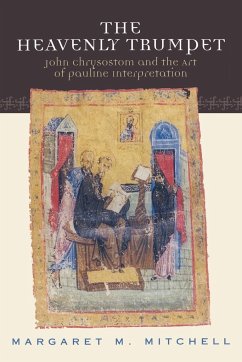Arguing that all Pauline interpretation depends significantly on the ways in which readers formulate their own images of the apostle, Margaret M. Mitchell posits that John Chrysostom, the most prolific interpreter of the Pauline epistles in the early church, exemplifies this phenomenon. Mitchell brings together Chrysostom's copious portraits of Paul--of his body, his soul, and his life circumstances--and for the first time analyzes them as complex rhetorical compositions built on well-known conventions of Greco-Roman rhetoric. Two appendices offer a fresh translation of Chrysostom's seven homilies "de laudibus sancti Pauli" and a catalogue of color plates of artistic representations that graphically represent the author/exegete dynamic this study explores.
Bitte wählen Sie Ihr Anliegen aus.
Rechnungen
Retourenschein anfordern
Bestellstatus
Storno








